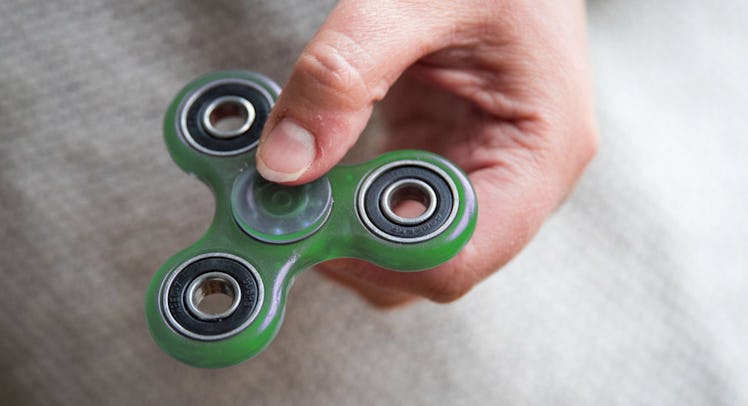There’s Real Science Behind Fidget Spinners
"Manipulatives" are nothing new, but mass adoption of a therapy tool could be damaging for children with real issues.

Following in the noble tradition of Silly Bandz, Yo-Yos, and Pogs, Fidget spinners are the latest fad to inspire school bans across the country. But, unlike their predecessors, Fidget spinners may have actual psychological value, with some clinicians recommending them to children coping with stress, anxiety, and developmental disorders. Though these devices (also called manipulatives) have been in use for some time, they’ve never been so widespread. And popularity can have some potentially damaging side effects.
“There is therapeutic value, but not for everyone,” Varleisha Gibbs, chair of the Masters of Occupational Therapy Program at Wesley College in Delaware, told Fatherly. “Stress balls, pinwheels—if you look in OT catalogues you’ll find these different things. For the classroom, we usually try to adapt the desk by putting velcro underneath it, so they can manipulate without being a visual distraction to anyone else.”
Fidget spinners, for those unfamiliar with the toys, are less inconspicuous. Shiny and occasionally fitted with LED lights, the three-pronged toys spin on a ball bearing that is held between the thumb and index finger. The oscillations can be calming for some, but they’re also complex and occasionally distracting, a far cry from the innocuous stress balls and velcro straps.
U.S. Air Force photo by Master Sgt. Jason Ellwinger
In recent months, Fidget spinners have exploded in popularity. One Manhattan-based company told the New York Post that it had sold more than 20 million spinners to retailers in April alone. And, like most popular but distracting children’s toys, popularity has led to school bans. But are educators missing out on an opportunity to bring a therapeutic, stress relieving device into the classroom?
Perhaps, according to Dr. Pilar Trelles, a psychiatrist and autism expert at Mount Sinai Health System in New York. “I think we all engage in some sort of fidgeting,” she told Fatherly. “It’s a coping strategy. I tell my patients to use stress balls, or to do something with their hands, to help them be more present.” Trelles uses these device to help children with autism or ADHD to process sensory stimuli and avoid harmful behaviors like nail biting and hair pulling.
Fidget spinners also produce calming, rhythmic oscillations, evoking the back and forth rocking motion that animals and humans innately use to cope with stress. “One theory is that the cerebellum—an area of the brain with a strong connection to movement—is always alert and waiting for something to happen, such as stress,” Gibbs says. “This very primitive part of our brain goes to rest when we rock back and forth.”
But fidgeting is not for everyone. “Rhythm is wonderful for the primitive parts of our brain, but those areas also respond strongly to visual input,” Gibbs says. “For children who have high arousal, this could cause them to be overstimulated and hyperactive.” Indeed, Trelles worries that some children with neurodevelopmental disorders “might become engaged with spinning behavior, and now it’s the only thing they’re doing.” In extreme cases, the devices may even pose medical risks. “One of the triggers for seizure disorders is strobe lights,” Gibbs says. Fidget spinners involve “repetitive firing of one visual system, and I would fear that could be a trigger.”
Fortunately, as long as the devices are used sparingly (Gibbs suggests no more than 10 minutes at a time) and under the guidance of an expert there is little cause for concern. “I don’t see them as being dangerous,” Trelles says. “They can do wonders for some children when used correctly.”
As for the crackdown in schools, Trelles says it is important that there be a balance between the need for classroom decorum and the needs of the individual child. “A child shouldn’t be anxious, moving around, unable to engage in friendships and learn,” she says. “Some of these things can be alleviated by spinning a toy in class. Whatever is in the best needs of a particular child.”
This holds true for kids who draw therapeutic benefit from the devices, Gibbs qualifies, but not necessarily for healthy children who fidget spin for fun in a way that distracts others. “I would hate to see a child that is benefitting from this have it taken away because of the craze,” Gibbs says. “If there isn’t a therapeutic reason to have it at school, it shouldn’t be there.”
This article was originally published on